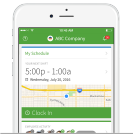Why You Need to Concentrate on Customer Experience This Year
Last month, the Salesforce Fourth Annual State of Marketing Report named customer experience as the new “brand battlefield” for 2017. According to their findings, brands of all sizes are now turning to customer experience as the new measure of success, with two-thirds of marketing teams across the country leveraging customer initiatives for a competitive advantage.
So why the sudden race to create award-winning customer experiences? It’s not just another buzzword—unlike as-needed customer service, customer experience focuses on building relationships with customers long before they ever intend to buy and long after. In a saturated market, this enhanced experience, not simply a great product, is essential in order to set your business apart.
Build the work schedule in minutes, communicate with employees, and handle schedule changes with ease with When I Work.

A good customer experience equals more than just good customers. It can also result in more revenue and more engaged employees. If you’re looking for an edge over the competition, here’s why this “brand battlefield” is worth fighting for:
1. It’s good for your business.
Consider this: you have a customer that comes in for coffee every morning. They spend $5 and head off to work. Over the course of a year, they generate a gross revenue of $1,800. Not too shabby, but not an amount that will have a lasting impact on your business.
Now, consider a second scenario: according to the Pew Research Center, the average American has 634 ties in their overall network. However, the network we interact with and share experiences with in real life is much smaller. The typical consumer shares a positive brand experience with about 9 people. Your $5 daily customer may amount to much alone, but what if you provided a customer experience so great that they had to share it with 9 others? Suddenly, their potential annual revenue isn’t $1,800, it’s $16,200.
A good customer experience can turn one-time buyers into loyal brand advocates who generate free interest in your business—to the tune of a 15 percent increase in revenue. When you create a positive customer experience, you’re not just making a great impression on a single customer, but earning their recommendation and potentially the business of their close network.
The brand advocate strategy works: 63 percent of top-performing B2Bs have integrated customer experience initiatives across their business. Additionally, a good customer experience has been shown to increase customer satisfaction by 20 percent and lift revenue by up to 15 percent. Customer service leaders can also earn 17 percent faster than competitors not focused on customer experience, all while lowering the cost of serving customers by as much as 20 percent.
The revenue potential for a good customer experience isn’t just limited to attracting new customers. Customers who have had the best past experiences with a company spend 140 percent more than those who have had a negative experience. They’re also willing to pay a premium for reliability. Up to 55 percent of consumers are willing to pay more for a “guaranteed good experience” and 9 out of 10 U.S. consumers say they would pay more to ensure a superior customer experience.
If you’re looking to set yourself apart from competitors and get a revenue boost, then turn the spotlight on those responsible for your revenue in the first place: your customers. Focus on building a great experience that benefits them, and your bottom line will benefit as well.
2. It’s good for your customers.
McKinsey Marketing partner Harald Fanderl defines a good customer experience as “putting customer needs at the center of what a company needs to do.” When your business prioritizes customer experience and customer needs, it becomes truly customer-first.
Building a good customer experience is about creating a positive experience for your customer from beginning to end. It could start the moment they see an ad online and click to learn more, when they physically walk in your front door, or even earlier.
Thanks to social media, first impressions can happen long before a customer interacts with your brand personally. With poor customer experiences going viral seemingly every week, consumers are growing increasingly distrustful of brands. Take a look at the most recent research:
- 61 percent of women don’t feel that brands are trustworthy because they don’t live up to the promises they make.
- 84 percent of millennials don’t trust traditional advertising.
- 42 percent of Americans find brands and companies less truthful today than 20 years ago.
- Two-thirds of consumers don’t trust brands to keep their personal data safe.
- According to consumers, customer service agents failed to answer their questions 50 percent of the time.
Going above and beyond typical customer service may make it seem like customers are asking a lot of your business, but in fact, they’re asking very little: over half of all customer churn is preventable if the customer’s issue was resolved upon first engagement.
The most requested improvement from customers is actually “better human service.” They don’t necessarily expect a customer experience that comes with a high price tag to your business. They just don’t want to be treated like another number. Instead, they want to hear a human voice that remembers their name and solves their problems.
Good customer experience is about making each customer feel respected, understood, and confident that they can trust you to follow through. In businesses where customers felt like the company “really gets them” or has “good intuition,” customers valued businesses they felt were authentic and prioritized brands who they believed were:
- trustworthy
- transparent
- lived up to their values consistently
So, what does living up to your values and creating a good experience for your customers actually look like? It depends on your customers’ buying environment. An in-person environment allows for an immediate human touch, but it also means that many environmental factors may be out of your control. Customers shopping in a physical environment are influenced by how other customers behave and ambient noise. They also tend to be more patient and less likely to write off a company for a less-than-favorable experience. In contrast, online shoppers contribute a faulty web experience to the company directly. Unlike customers who are less likely to walk out of a physical store, online shoppers will abandon a site if the page load time is longer than 10 seconds.
In both instances, the Harvard Business Review suggests focusing on the parts of the customer experience you can control. Create a consistent, reliable customer experience online and in person. Prioritize efficiency, but not at the customer’s cost. Have a direct contact for customer service issues and a framework to escalate the situation. Make sure the touchpoints in the customer journey are simple and seamless, like ordering ahead of time and skipping the line or easily being able to track shipping for an online purchase.
Ultimately, customer experience is about creating connection and showing customers that they have a greater value beyond their wallets. Seventy percent of buying experiences are based on how the customer feels they are being treated. Treat them well, and watch a buying experience transform into a long-term relationship that’s mutually beneficial.
Build the work schedule in minutes, communicate with employees, and handle schedule changes with ease with When I Work.

3. It’s good for your employees.
The correlation between happy employees and happy customers is clear:
- Customer experience leaders have 1.5 times as many engaged employees.
- Employees who feel motivated and engaged at work are 12 percent more productive than their disengaged peers.
- Engaged employees are more than four times as likely to recommend the company’s products and services.
While a great customer experience may be customer-first, it’s employee-based. Just like customers crave a trustworthy and authentic experience, so do your employees. Customer-focused companies are usually also employee-focused companies and are more likely to create good experiences for employees along with their customers. It’s no accident that customer experience giants like Zappos, Delta, Costco, and Apple also top the charts in employee job satisfaction and employee engagement.
Employee experience influences customer experience and vice versa. When employees are happy and engaged at work, they’re able to share that experience with your customers. They’re able to truly live and embrace your business’s values and build trust with customers searching for authenticity. And as any manager knows, convincing unmotivated, unengaged employees to go the extra mile for your customers is a lot harder than asking motivated, happy employees to extend their passion about your company to your customers. After all, happiness is catching. Up to 15 percent of people report feeling happier after being around happy people.
Companies with engaged employees grow profits up to three times faster than their competitors. So instead of building your customer experience alone, turn to the people who know your customers best: your employees. Leverage their expertise to craft a memorable customer experience and identify customer pain points and opportunities to improve. Follow best practices for keeping employees engaged and motivated, including recognizing them for their hard work and helping them bond outside of the office.
When employees are aligned with a company’s mission and values, they’re empowered to do their best work and their best for your customers. Setting a clear mission and being transparent about your customer experience values can inspire employee engagement, foster customer engagement, and help boost company performance.
___
There is a reason why brands are scrambling to make a good first impression: a customer-first approach can set your business apart from competitors, increase your overall revenue, and transform your regular customers into loyal brand advocates. Customer experience is no longer a nice-to-have, but a must-to-have. By prioritizing customer experience in your business this year, your team can approach this latest brand battlefield as a united front and achieve lasting results for you, your customers, and your employees.






